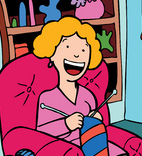There are many commonly held misconceptions about knitting machines. In order to decide which knitting machine will or will not work for you, it is first important to know exactly what you plan to be doing with the knitting machine. You also need to factor in what types of yarn you will be using to knit with as the different knitting machines are set up only for specific types and sizes of yarn. In short, before you decide which knitting machine is the one that you are going to purchase, you need to make certain that it will fit your personal needs.
If you are a very versatile person and commonly knit with many different types, sizes and styles of knitting yarn, it is highly unlikely that you are going to find any single knitting machine that will do everything that you are already able to complete by hand. Furthermore, the knitting machines are not going to be able to create all of the specific knots and stitches that you do. Again, the basic mechanics of knitting make it extremely difficult for all but the most expensive commercial knitting machines to perform even a fraction of what you are currently doing by hand.
Even then, the knitting machines will have different uses and there is still a need for many different and “specialized” knitting machines. Contrary to popular belief, the knitting machines will not fully automate the entire process and greatly increase your output … at least not until you learn all of the little quirks in regards to whatever brand knitting machine you ultimately decide on purchasing. That is because each individual machine is going to be different for more than just the types and sizes of yarn that you are using.
The needles will all be spaced at different intervals depending on the knitting machine that you choose. The latch hooks are all firmly locked into place so the number of threads and the stitch size will always be constrained by this. Thus, you can purchase a knitting machine to stitch heavy yarn for sweaters and such or a knitting machine that will allow you to knit socks but unless you want some really strange looking clothes, you are going to have to compromise some.
Patterns may also be substantially different for knitting by hand than it is for the knitting machines. When you are knitting by hand, all of your stitches will be measured as you go and you have at least a modicum of control over what the final product ends up as. With a knitting machine, you may still have the same control but you lose some of the flexibility that you would have when knitting by hand. The knitting machine cannot see and think the way that a human can so by its very nature, there are always going to be some limitations.
If you only want or need a knitting machine to perform one single function in your production, you will have a much easier time selecting the proper knitting machine. However, if you are looking for a flexible knitting machine that can handle a number of tasks for you, the decision may be a bit more difficult. The two most important things for you to remember are to clearly define what you need the knitting machine to handle and then to learn enough about the knitting machines so that you know which machine will perform that function with the least probability of additional work on your part. Then again, that is why we built this site … so that you could get all of the relevant information and make an informed decision regarding which knitting machine will be best for you. There is unfortunately, no simple answer to this question.





Very nice tips on knitting. I’m looking for a knitting machine as well, hope to find one that suit me soon.